
Futurism was an artistic and social movement that originated in Italy, and to a lesser extent in other countries, in the early 20th century. It emphasized dynamism, speed, technology, youth, violence, and objects such as the car, the airplane, and the industrial city. Its key figures included Italian artists Filippo Tommaso Marinetti, Umberto Boccioni, Carlo Carrà, Fortunato Depero, Gino Severini, Giacomo Balla, and Luigi Russolo. Italian Futurism glorified modernity and, according to its doctrine, "aimed to liberate Italy from the weight of its past." Important Futurist works included Marinetti's 1909 Manifesto of Futurism, Boccioni's 1913 sculpture Unique Forms of Continuity in Space, Balla's 1913–1914 painting Abstract Speed + Sound, and Russolo's The Art of Noises (1913).
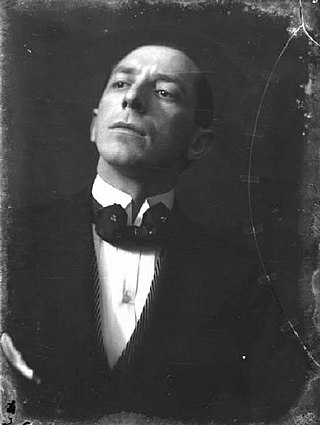
Umberto Boccioni was an influential Italian painter and sculptor. He helped shape the revolutionary aesthetic of the Futurism movement as one of its principal figures. Despite his short life, his approach to the dynamism of form and the deconstruction of solid mass guided artists long after his death. His works are held by many public art museums, and in 1988 the Metropolitan Museum of Art in New York City organized a major retrospective of 100 pieces.

Giacomo Balla was an Italian painter, art teacher and poet best known as a key proponent of Futurism. In his paintings, he depicted light, movement and speed. He was concerned with expressing movement in his works, but unlike other leading futurists he was not interested in machines or violence with his works tending towards the witty and whimsical.

Gino Severini was an Italian painter and a leading member of the Futurist movement. For much of his life he divided his time between Paris and Rome. He was associated with neo-classicism and the "return to order" in the decade after the First World War. During his career he worked in a variety of media, including mosaic and fresco. He showed his work at major exhibitions, including the Rome Quadrennial, and won art prizes from major institutions.

The Funeral of the Anarchist Galli is a painting by Italian painter Carlo Carrà. It was finished in 1911, during the artist's futurist phase, and is considered Carrà's most famous piece. The piece depicts the violent funeral of anarchist Angelo Galli, an event Carrà witnessed in his early adulthood. The piece was first displayed in 1912 and has been described as chaotic and violent. Since 1948, it has resided in New York City's Museum of Modern Art.

The Estorick Collection of Modern Italian Art is a museum in Canonbury Square in the district of Islington on the northern fringes of central London. It is the United Kingdom's only gallery devoted to modern Italian art and is a registered charity under English law.
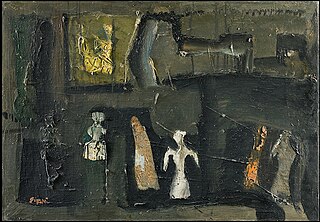
Mario Sironi was an Italian Modernist artist who was active as a painter, sculptor, illustrator, and designer. His typically somber paintings are characterized by massive, immobile forms.

The City Rises (1910) is an oil painting by the Italian painter Umberto Boccioni. It was his first major Futurist work.

Unique Forms of Continuity in Space is a 1913 bronze Futurist sculpture by Umberto Boccioni. It is seen as an expression of movement and fluidity. The sculpture is depicted on the obverse of the Italian-issue 20 cent euro coin.
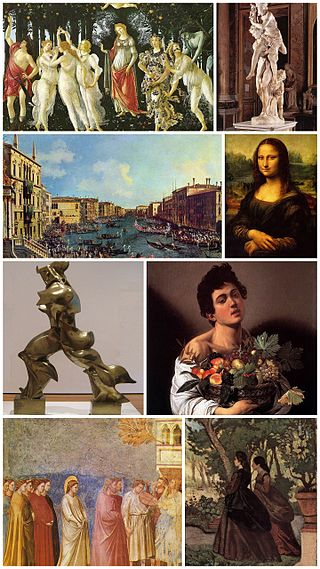
Italian Contemporary art refers to painting and sculpture in Italy from the early 20th century onwards.
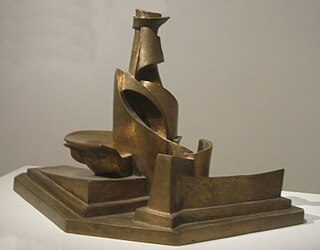
Development of a Bottle in Space is a bronze futurist sculpture by Umberto Boccioni. Initially a sketch in Boccioni’s "Technical Manifesto of Futurist Sculpture"," the design was later cast into bronze by Boccioni himself in the year 1913. Consistent with many of themes in Boccioni’s manifesto, the work of art highlights the artist’s first successful attempt at creating a sculpture that both molds and encloses space within itself.

Girl Running on a Balcony is a 1912 painting by Giacomo Balla, one of the forerunners of the Italian movement called Futurism. The piece indicates the artist's growing interests in creative nuances which would later formally be realized as part of the Futurist movement. The artist was heavily influenced by northern Italians' use of Divisionism and the French's better-known pointillism. Created with oil on canvas just on the brink of World War I, the Futurist movement is embodied by a dark optimism for a future of speed, turbulence, chaos, and new beginnings. Most of Giacaomo Balla's pieces allude to the wonder of dynamic movement, and this painting is no exception. The oil painting is now in the Museo del Novecento, in Milan.

Dynamism of a Cyclist is a 1913 oil painting by Italian Futurist artist Umberto Boccioni (1882–1916) that demonstrates the Futurist fascination with speed, modern methods of transport, and the depiction of the dynamic sensation of movement.
The Futurist Painting: Technical Manifesto (1910) by Umberto Boccioni (1882-1916) was the first exposition of the theoretical underpinnings of Italian Futurist painting.
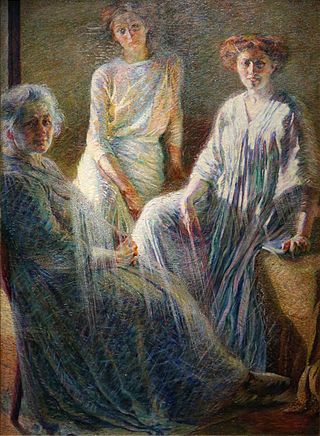
Three Women is a painting by Italian artist Umberto Boccioni, executed between 1909 and 1910. This painting is oil on canvas painted in the style of divisionism. Divisionism refers to the actual division of colors by creating separated brush strokes as opposed to smooth, solid lines. The painting contains three figures, one being Boccioni's mother Cecilia on the left, another being his sister, Amelia on the right, and the third being Ines, his lover, in the center.
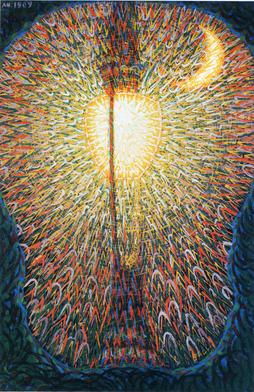
Street Light (also known as The Street Light: Study of Light and Street Lamp (Suffering of a Street Lamp)) (Italian: Lampada ad arco) is a painting by Italian Futurist painter Giacomo Balla, dated 1909, depicting an electric street lamp casting a glow that outshines the crescent moon. The painting was inspired by streetlights at the Piazza Termini in Rome.

Růžena Zátková, also called Rougina Zatkova, was a painter and sculptor who has been regarded as the "only authentic Czech futurist." As a result of her Bohemian heritage and her decade-long residency in Rome, Růžena Zátková became an important artistic link between Russian and Italian Futurism. Zátková is considered one of the pioneers of kinetic art.

Cyclist is a 1913 Cubo-Futurist painting by the Russian artist Natalia Goncharova. The painting is considered an "archetypal work" of Futurism by its current holder, the State Russian Museum.

Erster Deutscher Herbstsalon was the title of an art exhibition that was organized in 1913 by Herwarth Walden in Berlin.

Large Bright Showcase is an oil-on-canvas painting by the German artist August Macke, executed in 1912. It is held at the Sprengel Museum in Hanover.



















